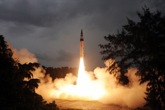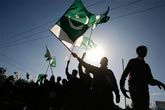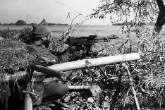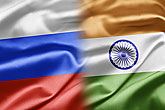How India’s Cold Start is making the world a safer place
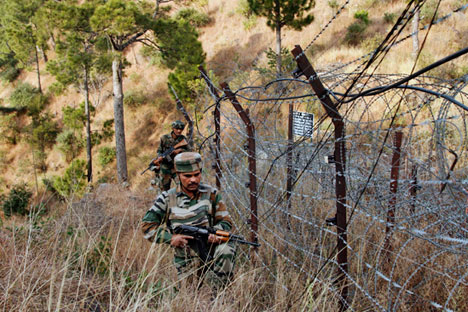
Indian army soldiers patrol near one of their forward posts at the Line of Control (LOC), that divides Kashmir between India and Pakistan. Source: AP
In the Russian view, there is another serious threat that should be discussed: Pakistan. Pakistan is a nation with nuclear weapons, various delivery systems and a domestic situation that is highly unstable. Russia assesses that Islamists are not only seeking power in Pakistan but are also trying to get their hands on nuclear materials.– Wikileaks, November 2010.
The Russian assessment of the Pakistani nuclear threat has to be seen in the backdrop of Islamabad’s insecurity-fuelled weapons programme. The country has not only cranked up its production of nuclear warheads, it is doing so primarily in the area of battlefield nuclear weapons designed for use against the Indian Army’s armour and troop concentrations. While Pakistan’s strategic arsenal is said to be under constant scrutiny by US intelligence agencies, the tactical warheads will be located in forward bases, presenting a tempting target for terrorist groups.
The exact number of nuclear warheads in any country’s armoury is a closely guarded secret, but guesstimates are that by the end of the decade Pakistan will overtake France’s tally of around 300 nuclear warheads.
Strange as it may seem, many in the West blame India for Pakistan’s nuclear underground. They are of the view that it is India’s new Cold War military doctrine that is accelerating the production of nuclear weapons next door. The fact that it's the Americans – along with China – who had actively helped Pakistan develop nuclear weapons is conveniently forgotten.
To be sure, Pakistan has embarked upon a wasteful militarisation programme that could wreck its economy because of the fear of India. According to Wikileaks, more than the al-Qaida, more than American plans to seize its nuclear stockpile, or even a hostile Afghan government, what’s causing jitters among Pakistani generals is Cold Start – a new version of blitzkrieg being perfected by the Indian Army.
So deeply does it dread Cold Start that the Pakistani military has increased its output to an all-time high of over 20 nuclear bombs annually. To understand why Pakistan is now upping the ante with battlefield nuclear weapons, we need to understand the dynamics unleashed by Cold Start.
India Army: Need for speed
India and Pakistan have fought wars in 1948, 1965, 1971 and 1999. Each of these conflicts was launched by the Pakistani military with the knowledge that if its military thrusts failed, its patrons – the US and China – could be relied upon to work the diplomatic back channels, get the world media to raise the alarm, and issue veiled threats, thereby bringing pressure upon India’s political leadership to call off its attack.
India’s military strategy was different. After the defending corps along the border soften Pakistan’s frontal positions, the mechanised columns of India’s elite strike corps roll across the border, destroy the core of the Pakistan Army and slice the country in two, giving the political leadership a huge bargaining advantage.
Sounds like a bullet-proof strategy. But because India’s strike corps were based in central India, a significant distance from the international border, it took up to three weeks for these three armies – comprising hundreds of thousands of troops – to reach the front.
Because of the long mobilisation period, the intervention by Western nations and the truce-happy nature of its political leadership, India’s military brass could not use its strike forces to their full potential.
Quick strikes
Cold Start was designed to run around this logistical Maginot Line. The doctrine reorganises the Indian Army’s offensive power away from the three large strike corps into eight smaller division-sized battle groups that combine mechanised infantry, artillery, and armour in a manner reminiscent of the Soviet Union’s operational maneuver groups. According to Dr Subhash Kapila, an international relations and strategic affairs analyst at the New Delhi-based South Asia Analysis Group, Cold Start aims to seize the initiative and finish the war before India’s political leadership loses its nerve.
“The long mobilisation time gives the political leadership time to waver under pressure, and in the process deny the Indian Army its due military victories,” says Kapila. “The new war doctrine would compel the political leadership to give political approval ‘ab-initio’ and thereby free the armed forces to generate their full combat potential from the outset.”
The crux of Cold Start is:
- Pakistan must not enjoy the luxury of time. Cold Start aims for eight “Battle Groups”, comprising independent armoured and mechanised brigades that would launch counterattacks within hours.
- These Battle Groups will be fully integrated with the Indian Air Force and naval aviation, and launch multiple strikes round the clock into Pakistan.
- Each Battle Group will be the size of a division (30,000-50,000 troops) and highly mobile unlike the strike corps.
- Ominously for Pakistan, the Battle Groups will be well forward from existing garrisons. India’s elite strike forces will no longer sit idle waiting for the opportune moment, which never came in the last wars.
Calculus of war
In a Harvard paper on Cold Start, Walter C. Ladwig writes, “As the Indian military enhances its ability to implement Cold Start, it is simultaneously degrading the chance that diplomacy could diffuse a crisis on the subcontinent. In a future emergency, the international community may find the Battle Groups on the road to Lahore before anyone in Washington, Brussels or Beijing has the chance to act.”
Cold Start is also aimed at paralysing Pakistani response. Although its operational details remain classified, it appears that the goal would be to have three to five Battle Groups entering Pakistani territory within 72 to 96 hours from the time the order to mobilise is issued.
“Only such simultaneity of operations will unhinge the enemy, break his cohesion, and paralyse him into making mistakes from which he will not be able to recover,” writes Gurmeet Kanwal, director, Centre for Land Warfare Studies, New Delhi.
Agrees Ladwig: “Multiple divisions operating independently have the potential to disrupt or incapacitate the Pakistani leadership's decision making cycle, as happened to the French high command in the face of the German blitzkrieg of 1940.”
Also, rather than seek to deliver a catastrophic blow to Pakistan (i.e., cutting the country in two), the goal of Indian military operations would be to make shallow territorial gains, 50-80 km deep, that could be used in post-conflict negotiations to extract concessions from Islamabad.
Where the strike corps had the power to deliver a knockout blow, the Battle Groups can only “bite and hold” territory. This denies Pakistan the “regime survival” justification for employing nuclear weapons in response to India's conventional attack.
Tactical nukes: Pakistan’s back-up
Pakistan has declared it will launch nuclear strikes against India when a significant portion of its territory has been captured or is likely to be captured, or the Pakistani military suffers heavy losses.
At the same time the Pakistani military is taking out another insurance policy – through battlefield nuclear weapons. The message is that Islamabad is prepared to use these compact warheads, which can be launched on purpose-built short range rockets, such as the much hyped Nasr, in the early days of war.
This can be interpreted in two ways. One, Pakistan has come round to the thinking that it can never defeat the Indian Army. Two, the Pakistani generals believe Cold Start cannot be allowed to stymie their plan to bleed India “with a thousand cuts”. In their view, achieving nuclear deterrence is not a victory but to stop their proxy war against India would be a defeat. This is not something to be taken lightly as it shows that the Pakistani elites want perpetual conflict with India in order to control Pakistani resources for their own benefit.
Calling the bluff
What if Pakistan uses tactical nuclear bombs against the Indian Army’s Battle Groups the moment Cold Start is initiated? In Kapila’s view, Pakistan’s low nuclear threshold is a myth – perpetuated and planted by Western academia and think tanks. This suits the needs of the conservative American establishment in whose eyes India is a long-term rival and Pakistan a useful, if unreliable, ally. Unfortunately, India’s political leadership and its uncritical media have been brainwashed into believing that Cold Start has apocalyptic consequences.
“Nuclear warfare is not a commando raid or commando operation with which Pakistan is more familiar," says Kapila. “Crossing the nuclear threshold is so fateful a decision that even strong American Presidents in the past have baulked at exercising it or the prospects of exercising it.” Pakistan cannot expect India would sit idle and suffer a Pakistani nuclear strike without a massive nuclear retaliation.
Broken arrows: Threat for the West, not India
The spectre of battlefield nuclear weapons under the direct control of commanders who sympathise with Islamic terrorists no doubt scares a lot of people. According to Wikileaks, in the Russian view, “extremist organisations have more opportunities to recruit people working in (Pakistan’s) nuclear and missile programmes”.
Although Pakistan’s strategic nukes are stored in well guarded depots, the miniaturised tactical nukes are harder to supervise 24/7. To ensure battlefield nuclear weapons are used at the opportune time, field commanders need independent charge and prior clearance. This is why German Army commanders have independent control of American nuclear warheads kept at NATO bases in Germany.
There is no need for New Delhi to feel alarmed. If, say, the al-Qaeda or the Islamic State manages to get hold of a battlefield nuke, the biggest threat is not to India but to Pakistan and the West. It is the West that made a Faustian bargain with Pakistan in order to target Russia. And like all Faustian bargains there comes a time to pay up. A broken arrow (code for a lost nuclear bomb) from Pakistan’s arsenal is more likely to explode in New York or London than New Delhi.
However, if these terrorists brandish nukes against India, it is Pakistan that will have to deal with the consequences. American strategic analyst, Ralph Peters, the author of Looking for Trouble, says: “Let India deal with Pakistan. Pakistan would have to behave responsibly at last. Or face nuclear-armed India. And Pakistan's leaders know full well that a nuclear exchange would leave their country a wasteland. India would dust itself off and move on.”
Islamabad is thus faced with the cold reality that India is prepared to undertake offensive operations without giving it time to bring diplomatic leverages into play. Since India has declared it will not resort to a nuclear first strike, the onus is on Pakistan and its patrons – the US and China. A South Asian nuclear exchange has the potential to spiral out of control, sucking in China, the US, the Islamic world and Russia. That would drive the global economy right over the cliff. Therefore, argues Kapila, “A nuclear conflict will take place in South Asia only if the United States wants it and lets Pakistan permissively cross the nuclear threshold.”
Without firing a shot
The beauty of Cold Start is it may never have to be used. It screws with the Pakistani military’s mind and forces the generals to spend time and scarce resources on finding ways to stop an Indian blitzkrieg.
Cold Start also works to undermine the much smaller Pakistani economy. According to the Pakistani media, the threat of the Indian Cold Start doctrine and increase in India’s defence budget has prompted the Pakistan government to sharply increase its defence budget, further increasing the strain on that country’s fragile economy.
However, if at all Pakistan uses tactical nuclear warheads on Indian armoured columns thundering towards its cities, it would end up devastating its own Punjabi heartland. Most Pakistani cities are close to the border and would become uninhabitable while India would lose only a small part of its army.
Cold Start was devised by India’s brightest military minds to end the standoff in the subcontinent. In their view, no country can be allowed to export terror and brandish nuclear weapons at India, without a fitting response.
As Chanakya wrote in the Arthashastra, the Indian treatise on statecraft, 2300 years ago: “The antidote of poison is poison, not nectar.”
All rights reserved by Rossiyskaya Gazeta.
Subscribe
to our newsletter!
Get the week's best stories straight to your inbox
